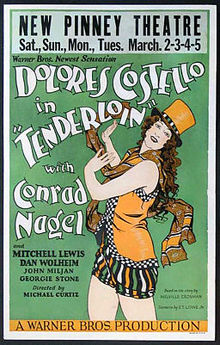|
Tenderloin (film)
Tenderloin is a 1928 American sound part-talkie crime film directed by Michael Curtiz, and starring Dolores Costello.[3] In addition to sequences with audible dialogue or talking sequences, the film features a synchronized musical score and sound effects, along with English intertitles. The soundtrack was recorded using the Vitaphone sound-on-disc system.[4] It was produced and released by Warner Bros. Tenderloin is considered a lost film, with no prints currently known to exist.[5][6][1] PlotRose Shannon (Dolores Costello), a dancing girl at "Kelly's," in the "Tenderloin" district of New York City, worships at a distance Chuck White (Conrad Nagel), a younger member of the gang that uses it as their hangout. Chuck's interest in her is as just another toy to play with. Rose is implicated in a crime which she knows nothing about. The police pick her up, and the gang sends Chuck to take care of her in the event she may know or disclose something that will implicate the gang. Cast
Premiere Vitaphone short subjectsTenderloin premiered at the Warners' Theatre in New York City on March 14, 1928.
ProductionTenderloin was the second Vitaphone feature with talking sequences that Warner Bros. released, five months after The Jazz Singer. The film contained 15 minutes of spoken dialog, and Warners promoted it as the first film in which actors actually spoke their roles. Reportedly, at the film's premiere, the feature was met with derisive laughter as a result of the film's stilted dialogue, resulting in two of the four talking sequences being eliminated during the first week of the film's premiere run.[7] Critic Harriette Underhill wrote that the "screen talking devices give the characters a certain lisp, slightly detracts from the serious effect."[8] CensorshipAfter the opening in New York City, the New York Censor Board objected to the scene in the farmhouse bedroom and requested that the dialog be removed. The sound was removed for the scene in next day's showing.[9] Box OfficeAccording to Warner Bros. records, the film earned $889,000 domestically and $96,000 foreign.[2] See also
References
Bibliography
External linksWikimedia Commons has media related to Tenderloin (film). |
||||||||||||||||||||||||||||||||||||||||||||





